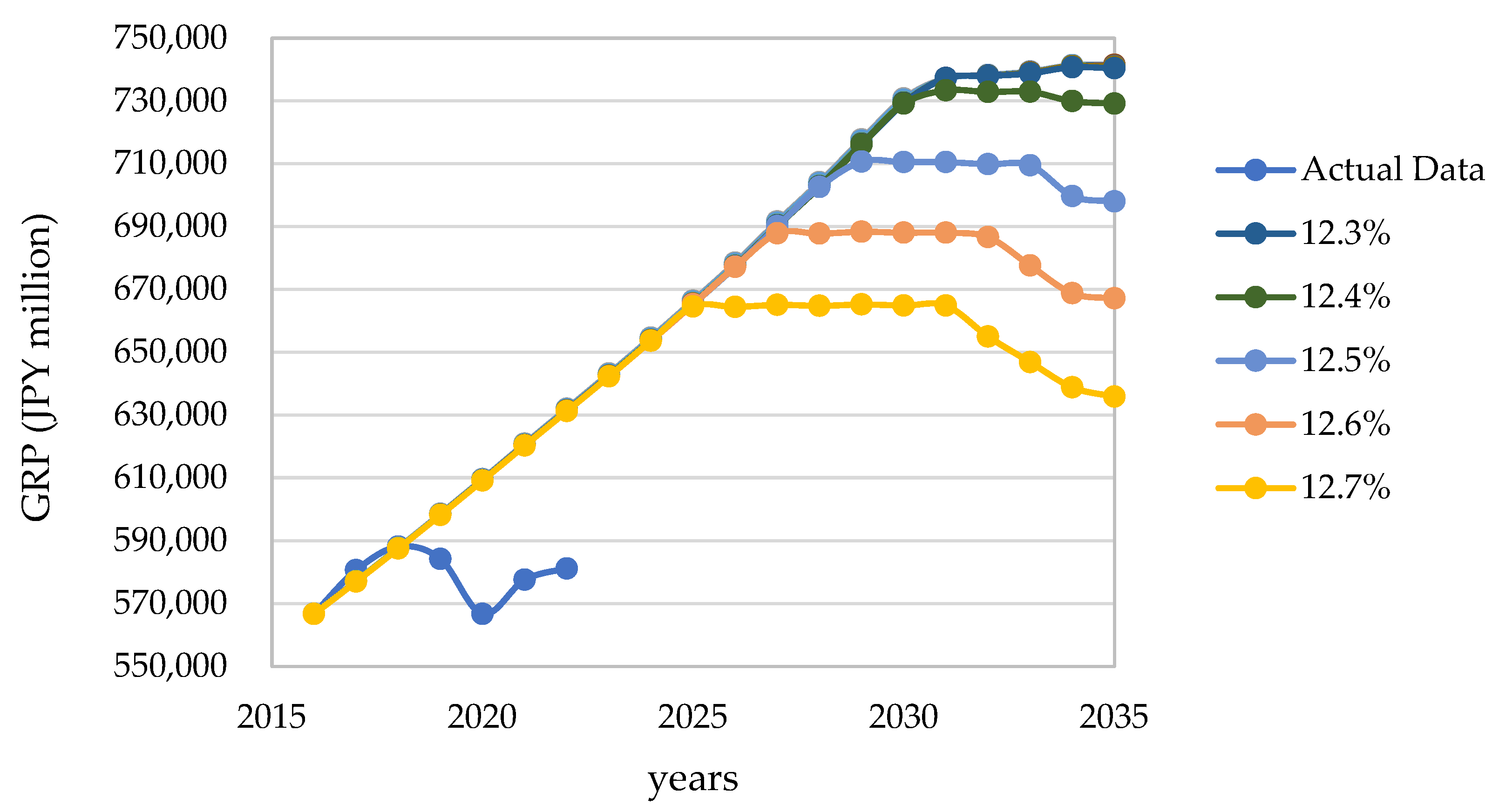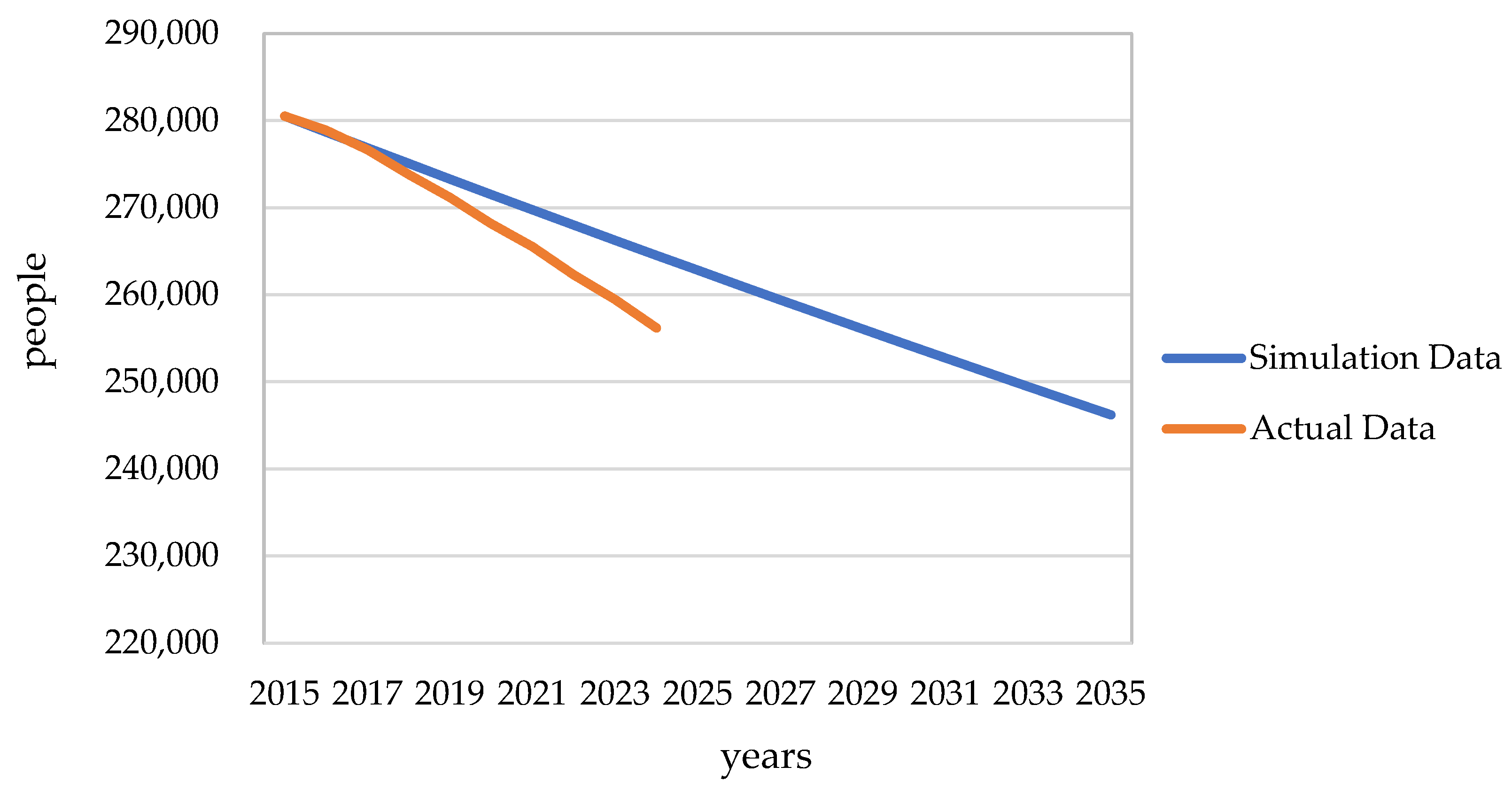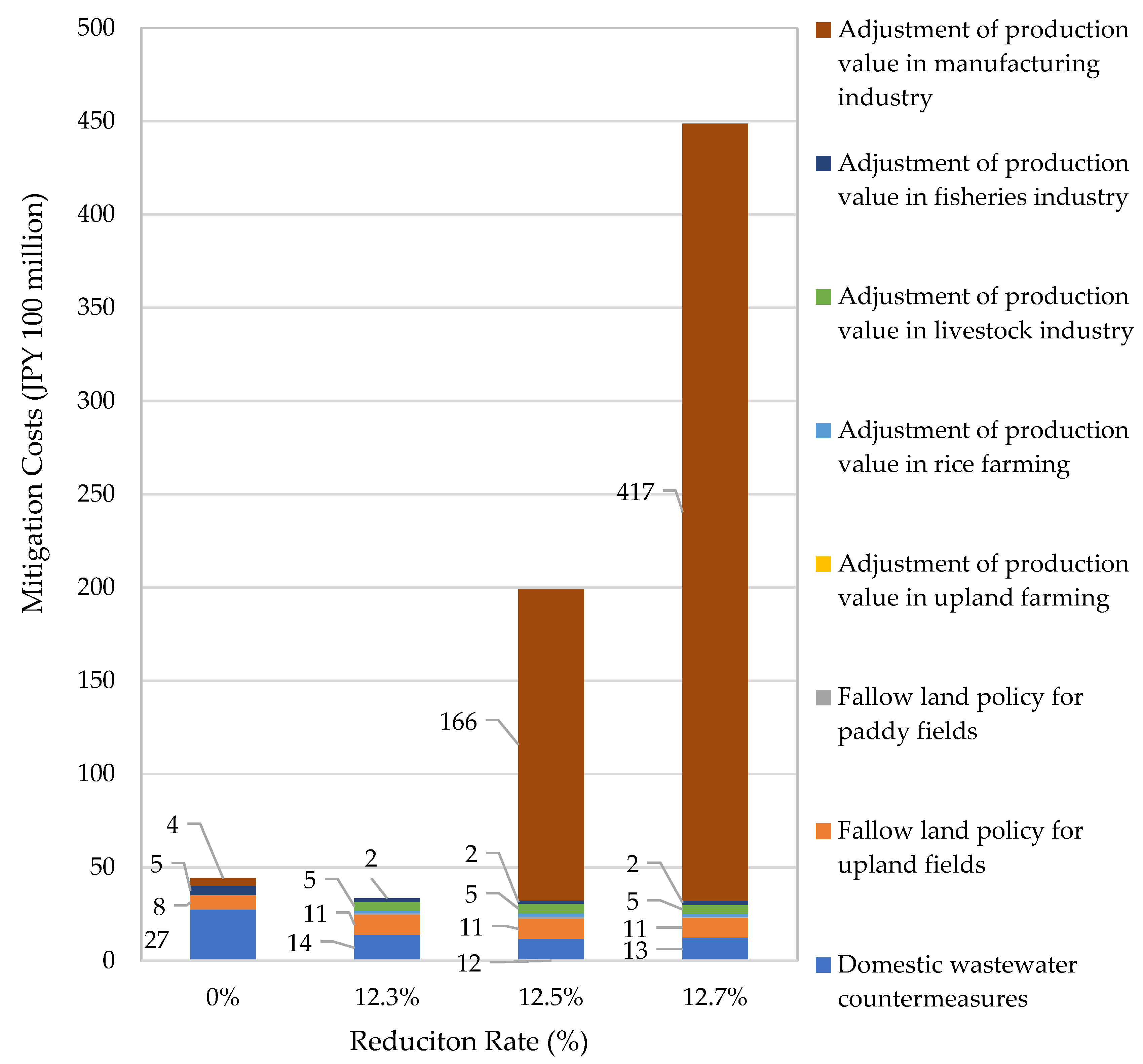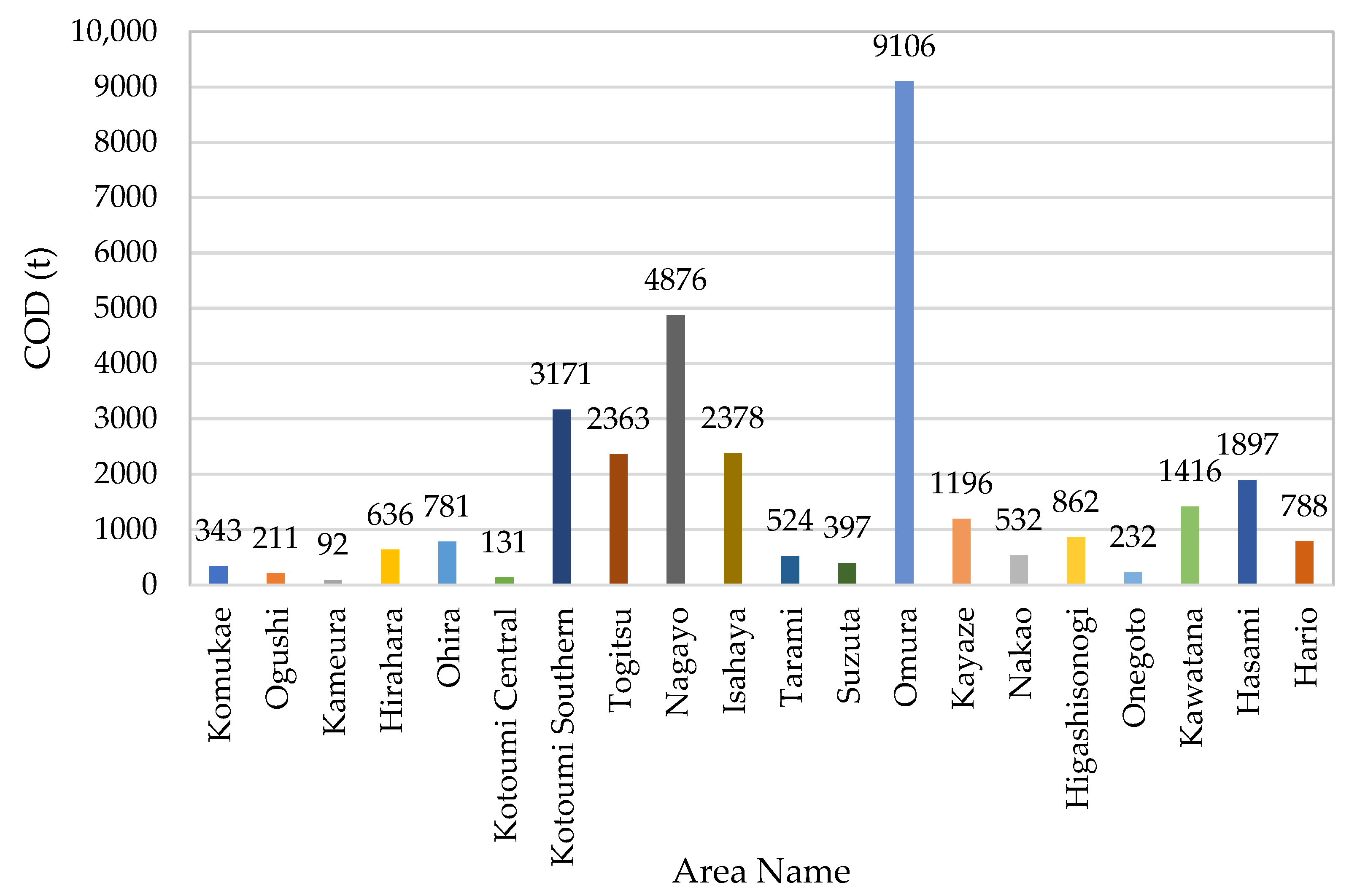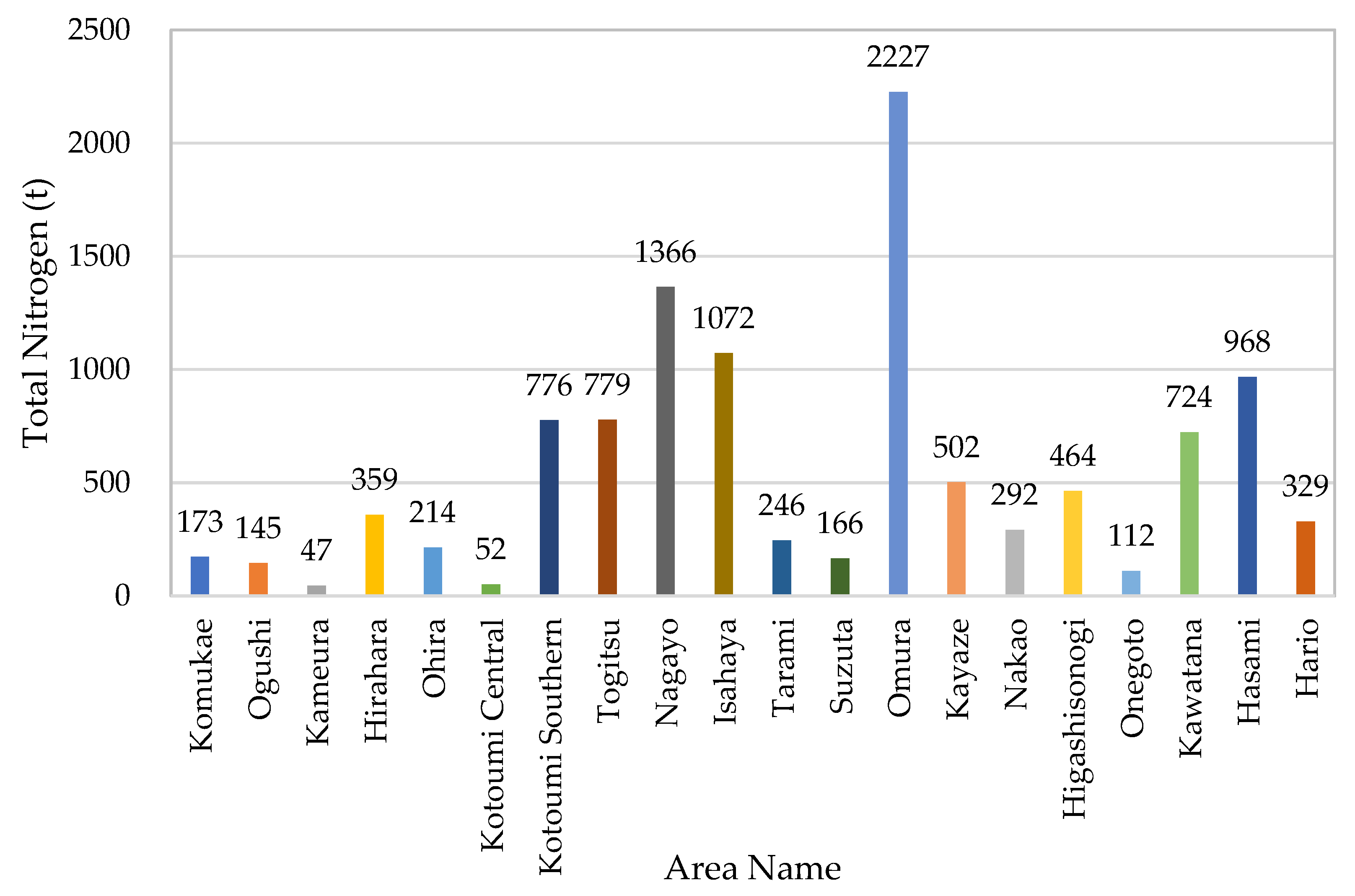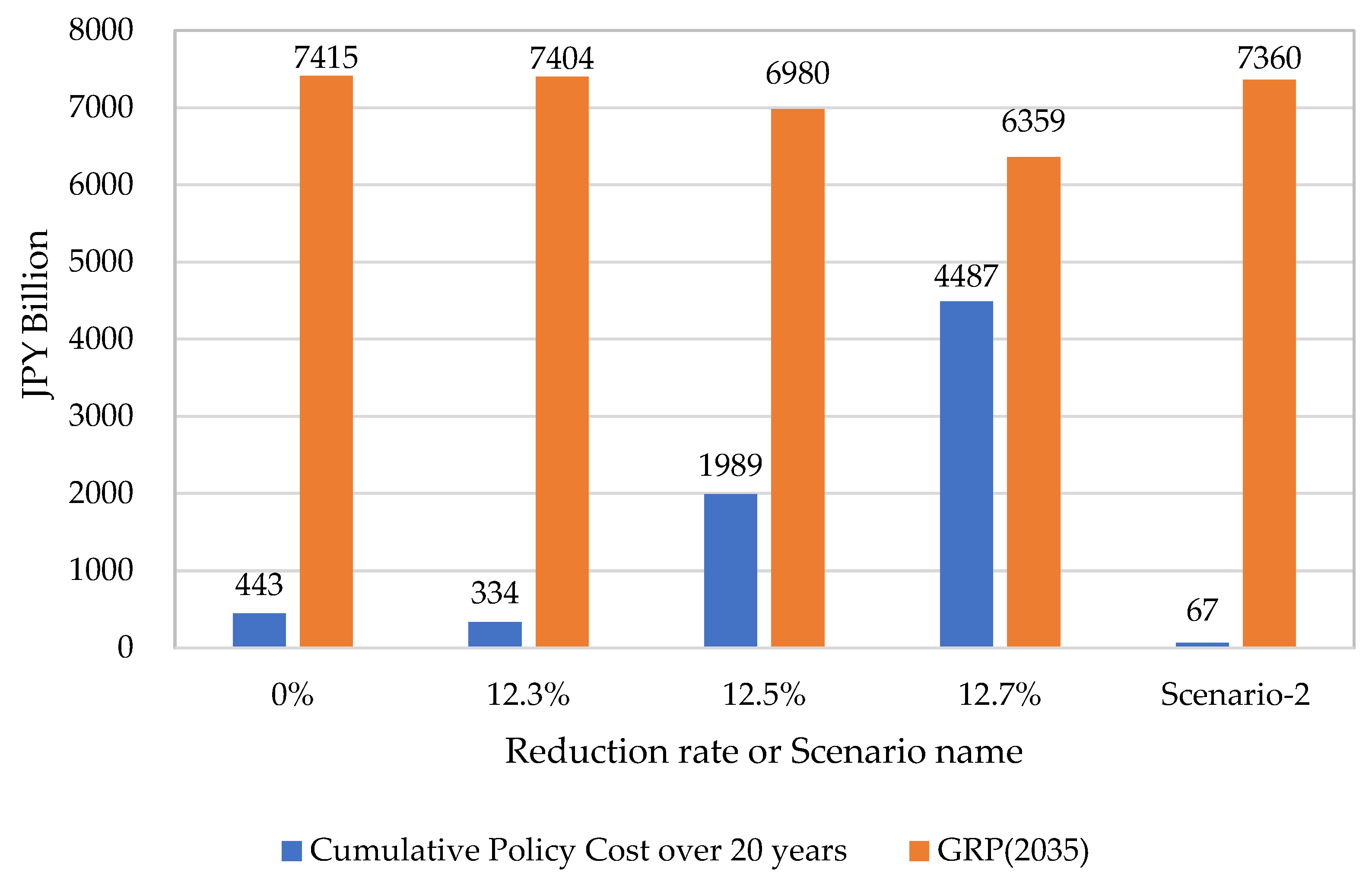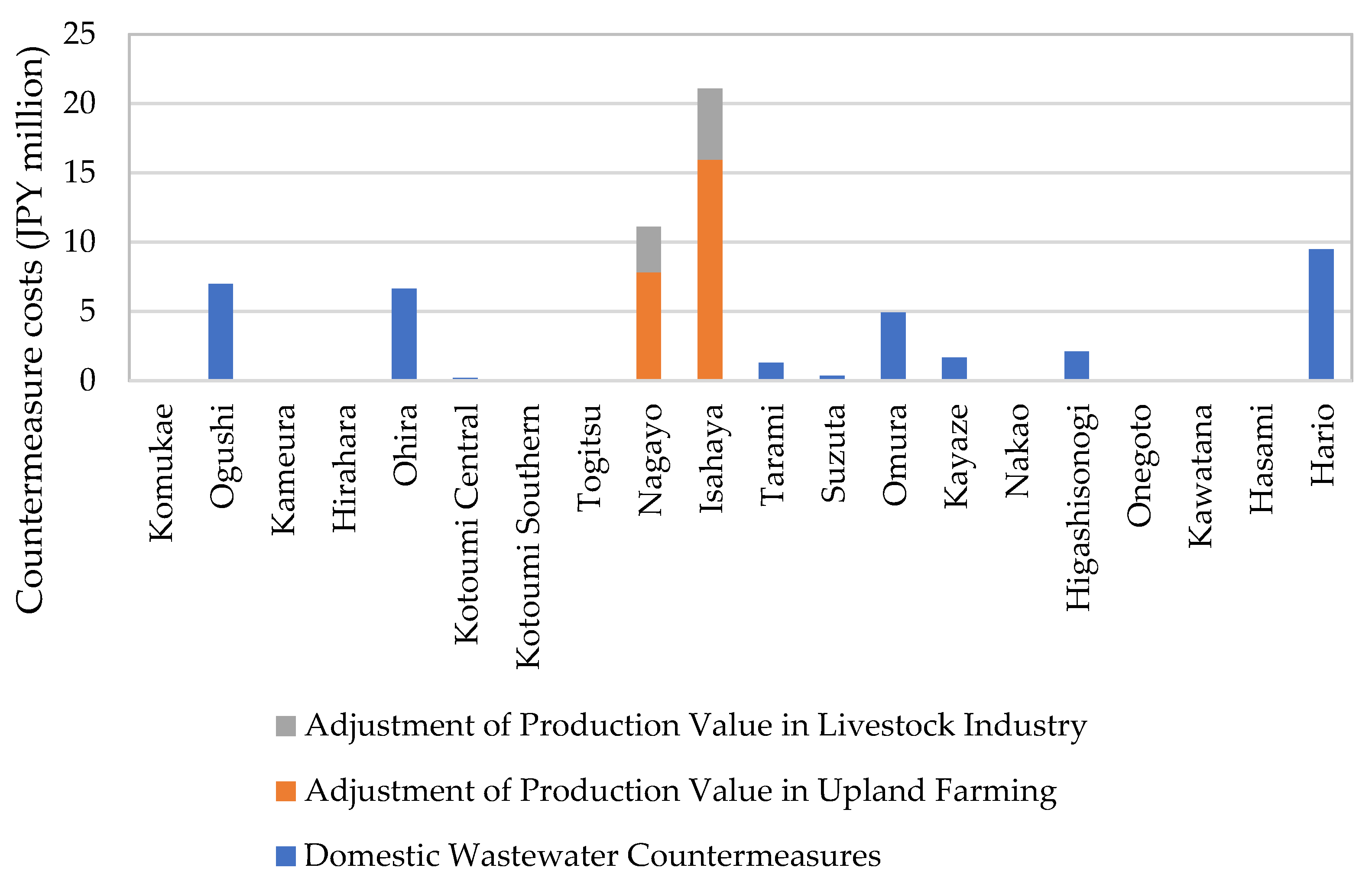1. Introduction
The core issue addressed in this study is the inherent conflict between regional socioeconomic development and environmental preservation in coastal watersheds. Pollutants that cause eutrophication in enclosed water bodies—namely COD (chemical oxygen demand), nitrogen, and phosphorus—are discharged through socioeconomic activities in the watershed. These pollutants flow into enclosed water bodies via rivers and advance eutrophication, disrupting the balance of the material cycle. Eutrophication itself is a major environmental problem that leads to a rapid increase in primary producers such as algae and cyanobacteria that feed on nutrients. This causes insufficient oxygen supply to the aquatic environment, the emission of toxic substances like H2S and CH4 and the occurrence of algal blooms in freshwater areas and red tides. Policies designed to mitigate these problems impose direct constraints on economic activities in bays and inland sea areas.
The results are a decline in water quality, changes in the structure and function of all biological communities—including plankton, benthic organisms, and fish—and damage to the ecosystem [
1]. These consequences not only have negative impacts on the natural environment but also cause economic losses through decreased fishery yields, reduced recreational opportunities, increased expenditures for the recovery of rare species, loss of value for drinking water use, and declines in the value of waterfront properties [
2]. As anthropogenic climate change is predicted to alter nutrient loads and amplify the degradation in water resources’ nutritional status, eutrophication is expected to become an even more pressing issue in the future [
3].
The Sustainable Development Goal to “conserve and sustainably use the oceans…” explicitly calls for preventing and significantly reducing marine pollution, including eutrophication [
4]. This goal was adopted at the 2015 United Nations Summit and is set to be achieved by 2030.
In Japan, eutrophication was observed after a period of high economic growth. Since then, various countermeasures have been implemented, including the establishment of environmental standards for nitrogen and phosphorus, wastewater regulation, and development of sewage treatment facilities. As a result of these efforts, the pollutant load from land has steadily decreased, and the water quality in enclosed water bodies is improving. However, the achievement rates of environmental standards for COD, total nitrogen, and total phosphorus vary by sea area, and problems such as red tides and hypoxic water masses persist [
5].
On the other hand, in areas where environmental limits in terms of water quality are significantly exceeded, improvements may have adverse effects on the fishing industry. For example, in the Seto Inland Sea, a decline in the concentration of nutrients in seawater has been reported to negatively impact fisheries [
6]. Additionally, the Okayama Prefectural Agricultural, Forestry and Fisheries Research Institute [
7] reported that a decrease in dissolved inorganic nitrogen concentration in seawater has led to poor oyster growth and suggested that maintaining appropriate nitrogen levels could help address this issue. In response, Hyogo Prefecture amended its ordinance in October 2019 [
8], becoming the first prefecture in Japan to set lower water quality limits for total nitrogen and total phosphorus. Furthermore, sewage treatment plants have adopted a seasonal operational management approach not only in the Seto Inland Sea area but also in Ise Bay, Mikawa Bay, and the Ariake and Yatsushiro Sea areas [
9].
Considering these circumstances, the Ministry of the Environment is promoting initiatives aimed not only at removing nutrients but also at maintaining a rich and diverse ecosystem with proper material circulation, known as the “Satoumi” approach [
10]. This study incorporates this innovative perspective by proposing proper nutrient management (Scenario 2) as a direct alternative to conventional total load control (Scenario 1), analyzing its specific economic implications. Modern environmental challenges, which involve multiple factors (e.g., water quality management, ecosystem conservation, and fishery operations), cannot be effectively addressed through a uniform management system [
9]. Furthermore, water quality is influenced by both natural characteristics (e.g., topography and depth) and social factors (e.g., population, industrial structure, and land use) [
11]. As such, management strategies must be tailored to the specific conditions of each region to ensure the sustainable conservation of marine environments and resources.
Omura Bay, located in the central part of Nagasaki Prefecture, Japan, serves as a critical case study. Its highly enclosed geographical nature makes it particularly vulnerable to pollutant accumulation in its watershed [
12], justifying its selection as the focus of this study. In Omura Bay, eutrophication is progressing in some locations while oligotrophication is advancing in others. Consequently, there is a concern that total load control across the entire bay could negatively impact the fishery industry. The “Satoumi” approach may be effective in such a situation.
Various ecological modeling approaches related to the eutrophication process have been developed to understand such regional conditions and to design specific individual policies. Hydrological and ecosystem models are essential for understanding pollutant transport and ecosystem responses [
13]. However, they often do not explicitly consider the economic costs of environmental policies. In contrast, economic models can evaluate the costs and benefits of various countermeasures. Among these models, integrated assessment models combining economic and environmental elements are particularly powerful tools for policy analysis. Various studies have examined the relation between socioeconomic activities and water quality improvement policies in enclosed water bodies. For example, Pretty et al. [
14] estimated that the economic losses caused by freshwater eutrophication in England and Wales amount to USD 105 million to 160 million annually, respectively, with policy response costs reaching USD 77 million per year. Similarly, Marita et al. [
15] evaluated policies for minimizing both the financial damage caused by eutrophication and the long-term costs of water quality improvements in the Gulf of Finland, concluding that modernizing wastewater treatment facilities and reducing nutrient loads from agriculture are the most effective measures.
Strokal et al. [
16] combined a model to assess nutrient inflows into the Yangtze River basin with cost optimization techniques. They found that achieving a desirable level of nutrient inflow to reduce the eutrophication risk by 2050 would require an annual cost of USD 1 to 3 billion, with the use of agricultural livestock manure being a highly cost-effective method. Hirose [
11] modeled socioeconomic activities and pollutant emissions in the Kasumigaura watershed using a comprehensive optimization model that integrated a regional Input–Output table with a linear programming framework. Through linear programming optimization simulations, this simulation demonstrated that a 14% reduction in pollutant discharge could be achieved without significant economic impacts. Furthermore, Mizunoya et al. [
17] clarified the effects of introducing new technologies with the aim of proposing more realistic policies. As demonstrated by these examples, the optimal measures for addressing eutrophication, their costs, and their socioeconomic impacts vary by region. To ensure both water quality improvements and the maintenance of socioeconomic activities in Omura Bay, an economic evaluation of water quality improvement policies is required.
Focusing on studies related to Omura Bay, Hyodo et al. [
18] estimated pollutant loads and water quality trends using satellite-based land cover classification, as well as statistical data on socioeconomic activities, such as sewerage penetration rates and industrial shipments. Their findings indicate that chemical oxygen demand (COD) loads in Omura Bay are heavily influenced by sewerage penetration, whereas the total nitrogen and total phosphorus loads are significantly affected by industrial and livestock activities.
However, no comprehensive analysis has been conducted to integrate regional economic structures and evaluate the trade-offs of environmental policies. In addition, Hidaka et al. [
19] constructed a framework for the previously mentioned Satoumi approach, noting the increasing attention paid to its ecological and material circulation approaches. However, it remains unclear how effective these methods are for tackling environmental challenges and what economic advantages they offer compared to existing approaches.
Therefore, this study explores economic approaches to reduce and manage pollutant discharges while simultaneously maintaining a balance between socioeconomic activities and the marine environment. We aim to bridge a gap in the literature by exploring an economic approach to managing pollutant discharges in the Omura Bay watershed.
Following the methodologies of Hirose et al. [
11] and Mizunoya et al. [
17], this study employs an environmental extension input–output model integrated with linear programming. This approach, based on Leontief’s foundational research and later applied to regional environmental analysis, offers distinct advantages for our research objectives. A significant advantage of this methodology is that, unlike purely ecological models, it explicitly simulates the trade-off between maximizing economic output (Gross Regional Product, GRP) and complying with environmental constraints (pollutant load reduction). This approach is highly applicable for policy analysis, as it enables detailed analysis of how policies, such as investments in wastewater treatment or adjustments to industrial production, affect the regional economy. This study explores economic approaches to reducing and managing pollutant discharges while maintaining a balance between socioeconomic activities and the marine environment. Through our analysis, we sought to determine the maximum achievable reduction in pollutant discharge without significantly affecting socioeconomic activities. Additionally, by considering the potential impact of significant water quality improvements on the fishing industry, we assessed the feasibility of appropriate pollutant inflow management tailored to regional characteristics, ultimately proposing effective water quality improvement policies.
2. Materials and Methods
2.1. Research Overview
We constructed a linear programming model based on input–output analysis for the Omura Bay watershed to quantitatively analyze the conditions that balance water quality conservation and socioeconomic activities. We conducted an optimization simulation, setting the target values for the amount of pollutants flowing into Omura Bay as constraints and maximizing the GRP within the watershed as the objective function.
The simulation model was formulated based on the framework developed by Hirose [
11] and Mizunoya [
17]. This framework is particularly suited for this study as it allows for a detailed analysis of the economic impacts of environmental policies across different industrial sectors.
Figure 1 shows the structure of the simulation. The model integrates the socioeconomic activities of the Omura Bay watershed, pollutants flowing into Omura Bay owing to these activities, and policies to reduce pollutants. The pollutants considered were nitrogen, phosphorus, and COD. We assumed that pollutants generated by socioeconomic activities in the watershed flow into Omura Bay through major rivers after undergoing natural purification processes. We also assumed that pollutants from wastewater treatment facilities along the Omura Bay coast, the fishery industry, and rainfall runoff flow directly into the bay.
We classified the pollutants generated from socioeconomic activities within the watershed into three categories: domestic, non-point source, and industrial. Domestic sources were further divided into five types based on wastewater treatment: sewage systems, rural community wastewater treatment, combined-treatment septic tanks, single-treatment septic tanks, and night soil treatment facilities. Sewage systems, rural community wastewater treatment, and combined-treatment septic tanks process both human waste and household wastewater, whereas single-treatment septic tanks and night soil treatment facilities process only human waste. We classified non-point sources into five land-use categories: farmland, rice paddies, forests, urban areas, and miscellaneous land (e.g., fallow land). We classified industrial sources into five categories based on pollution load generation: agriculture (upland and rice farming), livestock, fisheries, manufacturing, and other industries. We assumed that the “other industries” category does not generate pollution loads.
The simulation incorporated policies to reduce pollutants emitted from domestic, non-point, and industrial sources within the watershed. To reduce pollutants from domestic sources, the government introduced policies promoting the development and installation of advanced treatment facilities. These policies increased the use of sewage systems, rural community wastewater treatment, and combined-treatment septic tanks in the population. For non-point sources, policies converting farmland into fallow land and maintaining forest area were implemented. To reduce pollutants from industrial sources, the government implemented policies adjusting production values through subsidies.
2.2. Study Area
The study area consists of the Omura Bay watershed in Nagasaki Prefecture, with a watershed area of 320 km
2 and a population of approximately 280,000, accounting for approximately 20% of the total prefectural population. The study area includes five cities (Saikai, Nagasaki, Isahaya, Omura, and Sasebo) and five towns (Togitsu, Nagayo, Higashisonogi, Kawatana, and Hasami). These were further divided into 20 blocks based on wastewater treatment facilities, major rivers, and environmental standard points located downstream in Omura Bay. These are shown in
Figure 2. We estimated the area, population, population trends, production value, and capital accumulation for each block from the proportion of the watershed area of the major rivers. Omura Bay is a double-closed bay, connected to the open sea only via the narrow Hario Seto and Haiki Seto straits. This enclosed nature, combined with calm waters, has traditionally supported pearl and oyster farming. However, the watershed has experienced significant human-induced transformations. Shallow coastal areas, such as seagrass beds and tidal flats, have been largely reclaimed, altering the bay’s hydrodynamic characteristics [
20]. Population growth and industrial activities have led to pollution loads that surpass the bay’s natural purification capacity [
21], resulting in persistent red tides and hypoxic water masses. In response, the Nagasaki Prefectural Government initiated the Omura Bay Environmental Conservation and Revitalization Action Plan in 2003 [
22], focusing on improving wastewater treatment coverage. Despite these efforts, water quality standards were frequently not met, leading to the fourth phase of the plan in 2019 [
23].
2.3. Model Details
2.3.1. Key Assumptions and Their Validity
This model was constructed based on several key assumptions. We present the rationale for these assumptions and their potential impact on the results. The parameters shown in the
Appendix A were calculated using Nagasaki Prefecture’s Input–Output Tables (2015) [
24], the Statistical Yearbook 2015 [
25], and the Cabinet Office’s data on private enterprise capital stock (2015) [
26]. Some data was also directly obtained from local governments in the target area.
Method for Calculating the Pollutant Load: Pollutant loads from various sources were calculated using the unit load method. This is a standard technique used in Japan’s environmental planning, recommended by government agencies such as the Ministry of the Environment [
27]. The total load is estimated by multiplying the activity levels by emission factors (pollutant load per unit of activity). The specific values for these factors were derived from established national and local guidelines and are detailed in
Table A2 in the
Appendix A. The emission factors used in this study were derived from values established in the Nagasaki Prefecture environment white book [
28], and national environmental guidelines [
27]. While this method provides robust, scientifically grounded estimates based on available statistics, it assumes uniform emission patterns within each category and cannot capture detailed location-specific variations.
Linear Relationships: This model employs linear programming, assuming linear relationships between variables (e.g., production volume and capital, investment and pollutant reduction). This simplification is key to the input–output analysis framework, which enables efficient optimization and clear interpretation of economic trade-offs [
29]. The nonlinearities existing in real-world environmental and economic systems featuring complex nonlinear relationships—as shown in research by Amazing et al. [
30], who applied machine learning models in environmental policy analysis—are acknowledged. However, linearity remains a common and widely accepted assumption in regional-scale economic–environmental modeling for analyzing first-order policy impacts; for example, see Yokosawa et al. [
31], Hirose et al. [
11], and others.
Base Year: The base year for this model is 2015. This is because of the latest version of the Nagasaki Prefecture Input–output Table [
24], which forms the core of the simulation model in this paper. To maintain consistency with this, the data used in this model is from 2015. We recognize that using a single year as the base year carries the risk that the economic conditions specific to that year may influence future projections, potentially limiting the generality and universality of the results. However, the primary objective of this study is not to precisely predict the absolute value of future GRP, but rather to compare and evaluate the relative impacts on the regional economy of different environmental policy scenarios—such as total pollutant load reduction and management tailored to regional characteristics—starting from the 2015 socioeconomic structure. Therefore, this approach avoids unrealistic, abrupt economic fluctuations and simulates the gradual impacts associated with policy implementation. As such, the future GRP and countermeasure costs presented in this paper are reasonable indicators for comparing the relative merits of policies and the magnitude of their economic impacts, rather than as absolute forecast values.
Pollutant Transport: This model assumes that a fixed proportion of pollutants generated within the watershed reaches Omura Bay, determined by the river transport coefficient (κj) representing natural purification. Under this assumption, κj was calculated based on river distances following Kunimatsu et al. [
32]. This simplifies complex hydrological processes, and is a major simplification used in many existing studies. The river transport coefficients (κ) for each of the watershed area (j) are provided in
Table A1.
2.3.2. Pollutant Load Inflow into Omura Bay
Pollutants discharged from the watershed flow into Omura Bay through major rivers. Pollutants from the fishery industry, effluent from wastewater treatment plants along the Omura Bay coast, and direct rainfall on the bay surface also contribute to this direct inflow. Thus, we modeled the pollutant load inflow amount as follows:
: Total pollutant load inflow into Omura Bay (kg).
: Pollutant load inflow from rivers (kg).
: Pollutant load from the fishery industry (kg).
: Pollutant load from wastewater treatment plant effluent (kg).
: Pollutant load from rainfall over the bay (kg).
The components of the pollutant load inflow are defined as follows. The riverine pollutant load is expressed as:
Regarding pollutant load from socioeconomic activities, we considered the following:
: Pollutant emission coefficient for domestic sources (row vector).
: Population by wastewater treatment type (column vector, people).
: Pollutant emission coefficient for non-point sources (row vector).
: Land Use Area (column vector, ha).
: Pollutant emission coefficient for industrial sources (row vector).
: Production output by industry (column vector, JPY).
The pollutant load from the fishery industry is assumed to be proportional to the industry’s production value.
where
P3 is the pollutant emission coefficient for the fishery industry (row vector) and
x3 is the production output of the fishery industry (column vector, JPY).
Wastewater is treated before being discharged into rivers and, eventually, into Omura Bay. However, facilities located along the bay discharge waste directly into the bay. We modeled the pollutant load from wastewater treatment plants as follows:
The pollutant load from direct rainfall into Omura Bay is calculated based on the bay’s surface area:
2.3.3. Domestic Sources
The rate of population change for each municipality in the watershed is assumed to be constant:
Regarding municipal fiscal revenue, we set the fiscal scale of a municipality as being proportional to its population:
The model includes the population served by various domestic wastewater treatment facilities. It is assumed that the total population served by these facilities equals the total municipal population.
Population using sewer systems (people).
Population using rural community sewage treatment (people).
Population using combined treatment septic tanks (people).
Population using single treatment septic tanks (people).
Population using night soil treatment facilities (people).
The increase in the population served by sewer systems and rural community sewage treatment is determined by municipal investments in these facilities:
: Investment in facility construction.
: Parameter representing facility expansion efficiency.
h = 1, Sewer systems; h = 2, Rural community sewage treatment.
The development of sewer systems and rural community sewage treatment is funded through municipal bonds and general account budget transfers. Maintenance is financed through usage fees, with any shortfalls covered by general account transfers. In our model, the cumulative project cost for a municipality must not exceed the total project cost:
Construction investment is determined by the municipality’s financial contributions and corresponding national subsidies.
Changes in the population using combined-treatment septic tanks are also modeled. This population increases through installation subsidies but decreases as sewer systems and rural community sewage treatment expand:
The subsidies for installing combined-treatment septic tanks are provided by national and prefectural governments, along with the general account budgets of municipalities. Our model accounts for this relation as follows:
δ: Installation cost per person for combined-treatment septic tanks (JPY).
: Subsidy ratio from national and prefectural governments.
: Municipality’s subsidy contribution (JPY).
The municipal expenditure for sewerage system development, rural community wastewater treatment, and subsidies for combined-treatment septic tank installations is determined by the financial capacity of each municipality. In our model, the constraint is expressed as follows:
This equation ensures that the total spending on wastewater management does not exceed the financial resources available to the municipality. Moreover, our model considered the transition of the population using different sanitation systems and night soil treatment facility, represented in Equations (15) and (16), respectively:
2.3.4. Non-Point Sources
The total land use area equals the total area of each municipality within the Omura Bay watershed. Our model accounted for land use as follows:
Our model also accounted for land use changes owing to conversions between different land use types.
In this study, we noted that direct conversion from forests and farmland to urban areas was restricted. Conversion to urban areas was only allowed from mixed-use land. Forest areas remained unchanged, and farmland could only be converted into mixed-use land.
Our study also accounted for the policy introduced to provide subsidies for fallowing farmland.
The change in urban and mixed-use land area is considered as follows. The increase in urban area is proportional to population growth and investments in manufacturing and other industries.
: Residential land demand function.
: industrial land demand function.
: Expansion in investment in manufacturing and other industries.
Finally, our model reflected the changes in mixed-use land area owing to conversion from farmland and conversion to urban land.
2.3.5. Industrial Sources
The level of production depends on capital accumulation. As agriculture heavily relies on farmland, farmland is also considered a form of capital accumulation. We accounted for production constraints as follows:
: Production constraint coefficient.
n = 11, upland farming; n = 12, rice farming; n = 2, livestock industry.
n = 3, fisheries; n = 4, manufacturing industry; n = 5, other industries.
The dynamics of capital accumulation are defined as follows. Capital decreases due to depreciation and increases through investment. The model incorporates a policy to regulate production and reduce pollution loads by providing subsidies that decrease capital. In agriculture, capital also decreases as farmland is reduced.
For industries other than agriculture,
: Capital accumulation of each industry (JPY).
: Investment amount of each industry (JPY).
: Depreciation rate for each industry (JPY).
: Subsidy for each industry (JPY).
: Parameters.
2.3.6. Omura Bay Countermeasure Costs
Nagasaki Prefecture allocates a budget for countermeasure costs to reduce the pollution load in Omura Bay. We accounted for Omura Bay countermeasure costs as follows:
2.3.7. Economic Indicators
In our model, the production value of each industry follows the following flow conditions in the product market.
Total investment in sewage and agricultural village drainage system construction (JPY)
A: Input–output coefficient matrix.
C(t): Consumption column vector.
: Sector-wise production inducement coefficient column vectors for sewage system improvements, agricultural village drainage, and combined-treatment septic tank installation.
e(t): Net export column vector.
Consumption is constrained by the total population within the watershed. We accounted for consumption constraints as follows:
We accounted for net export constraints as follows:
Regarding GRP, we used the GRP as the economic indicator for municipalities, defined as the sum of the value added by each industry.
2.3.8. Objective Function and Limiting Condition
We set target values for the pollution load flowing into Omura Bay to maximize the GRP of the municipalities in the Omura Bay watershed while satisfying this constraint at time T. The objective of this research is to find the optimal policy that minimizes socioeconomic costs (equivalent to maximizing achievable GRP) while ensuring that environmental standards are met as a constraint. The following equation represents the objective function and constraints. The objective function is to maximize GRP, while the constraints involve controlling the inflow of pollutants. This approach is valid as a constrained optimization problem, as it seeks the option with the least economic impact within the absolute constraint of environmental standards. This allows for a quantitative evaluation of the trade-off between the environment and the economy.
2.4. Simulation
We conducted the simulation using LINGO, a mathematical computation software by LINDO SYSTEMS. The baseline was established by calculating the pollutant load emissions and GRP of the watershed based on data from the 62nd Edition of the Nagasaki Prefecture Statistical Yearbook. In addition, the simulation employed a model constructed using the 2015 Nagasaki Prefecture Input–Output Table. We employed two scenarios to modify the constraints on pollutant inflow. Additionally, to prevent abrupt changes in socioeconomic activities within the watershed over a short period, we limited the annual decrease in production value for each industry to a maximum of 10% per year and up to 30% of the 2015 level.
2.4.1. Scenario 1: Reduction in Total Pollutant Load Inflow
Scenario 1 aimed to determine the achievable total reduction in pollutant inflow into Omura Bay without significantly impacting socioeconomic activities in the watershed. As a constraint condition in the simulation, total emission limits were set for three pollutants: COD, total nitrogen, and total phosphorus. We set the regulatory reduction rates at four levels: 0%, 5%, 10%, and 15% of the total pollutant load in Omura Bay in 2015.
2.4.2. Scenario 2: Pollutant Load Management
Scenario 2 aimed to explore the feasibility of introducing an appropriate pollutant load management policy in the Omura Bay watershed, considering the impact of significant water quality improvements on the fishery industry. We set water quality target values for COD, total nitrogen, and total phosphorus (
Table 1). For each of the 20 blocks in the study area, we determined the pollutant inflow target values based on the pollutant with the worst actual water quality relative to the target value in Omura Bay.
Since the environmental measurement data for 2015 was not publicly available, we used the data from 2017 [
8], the closest year with published information, to set the target pollutant inflow load values. Therefore, this scenario was conducted using the pollutant inflow load for 2017. The set pollutant load target values are adopted in the model strictly as constraint conditions and do not affect the model’s structure or the simulation dynamics. Additionally, for convenience, the following proportional Equation (34) was assumed to hold, and achieving the pollutant load target value by 2035 was set as a constraint in the simulation.
The water quality target values were set to be optimal for both environmental concerns and the fishery industry. For this study, the target for environmental concerns was defined as the current upper limit of the environmental standard for Omura Bay, set by the Ministry of the Environment. The target for the fishery industry was defined as the lower water quality target limit adopted in the Seto Inland Sea [
8], which is the only region in Japan with such a lower limit. As shown in
Table 1, these two target values coincided. Therefore, this value was adopted as the water quality target for this research. Based on 2017 levels, the pollutant inflow targets for 2035 were set as follows:
COD: Increased in five regions, reduced in eight regions, and constant in four regions.
Total nitrogen (T-N): Reduced in two regions.
Total phosphorus (T-P): Reduced in one region.
4. Discussion
4.1. The Difference in GRP
Figure 9 shows the differences in GRP when inflow is managed, the current conditions are maintained, and the total amount is reduced. The final GRP in 2035 under the inflow management scenario was JPY 7.360 trillion. This value is approximately JPY 5.5 billion lower compared with the 0% reduction case, where current conditions were maintained, and approximately JPY 4.5 billion lower compared with the 12.3% reduction case, where the maximum possible reduction was achieved without significantly decreasing GRP. However, this value is also approximately JPY 100 billion higher compared with the 12.7% reduction case, in which maximum reductions are the goal. As the decrease compared to that under the situation maintaining the current conditions was only about 0.8%, the policy of managing inflow had little impact on the GRP.
4.2. Budget Allocation for Countermeasures in Omura Bay
The findings indicate that the domestic wastewater treatment facility development policy is highly cost-effective and can be prioritized owing to its minimal impact on GRP. Additionally, production adjustment policies in the fisheries and livestock industries, which had particularly high emission ratios in 2015, are also highly effective. Furthermore, when the reduction rate exceeds 12.3%, reducing inflow pollution through production adjustments may be prioritized over domestic countermeasures. Although production adjustment policies can lower the GRP, and the manufacturing production adjustment policy significantly increases countermeasure costs, they also yield substantial reductions in pollutant inflows.
Figure 9 shows the countermeasure costs in the cases of 0% reduction in inflow pollutants, 12.3% reduction, and inflow management. The results indicate that the inflow management policy scenario (Scenario 2) can significantly reduce countermeasure costs, making it an effective approach. Meanwhile, GRP is higher in the case of total reduction; therefore, when implementing inflow management policies in practice, the impact on GRP must be minimized as much as possible.
Figure 10 shows the costs and breakdown of policies implemented in each region under Scenario 2. The data suggests that production adjustment policies were effective in Nagayo and Isahaya, where nitrogen was reduced, whereas wastewater countermeasures were effective and efficient in other regions where COD or phosphorus was reduced. Notably, countermeasure costs were particularly high in regions where nitrogen (Nagayo, Isahaya) and phosphorus (Hario) were reduced. Therefore, introducing new technologies to recover and effectively utilize nitrogen and phosphorus in these regions could enable more efficient inflow management.
4.3. Research Value
The most important novelty of this study lies in introducing a new perspective—proper nutrient management (Scenario 2)—to complement the conventional one-dimensional evaluation of pollution load reduction measures. In this study, we quantitatively assess the economic and policy implications of this approach. As seen in recent years in the Seto Inland Sea and other areas, it has been indicated that excessive water purification potentially adversely affects fisheries. This study represents a pioneering attempt to use an economic model to concretely demonstrate sustainable water quality management approaches that also consider these negative aspects. Furthermore, it holds academic value in using an environmental economics approach to visualize the complex trade-off between “environmental conservation” and “regional economic activity” in enclosed sea areas, expressed as specific policy costs and changes in Gross Regional Product (GRP). Specifically, identifying the “tipping point” where pollution load reduction rates exceeding 12.3% cause countermeasure costs to surge sharply and GRP to decline significantly provides crucial insights for setting policy targets based on scientific evidence. The simulation results from this study can serve as a powerful decision-making support tool for formulating and evaluating concrete policies like Nagasaki Prefecture’s “Omura Bay Environmental Conservation and Restoration Action Plan.” The analysis shows that a management approach (Scenario 2) tailored to regional characteristics minimizes the impact on GRP. This approach also reduces countermeasure costs to approximately one-sixth (JPY 44.3 billion → 6.7 billion) compared to a uniform total quantity regulation (Scenario 1). This finding offers potentially crucial implications for designing highly cost-effective environmental policies. The simulation model developed in this study can be applied not only to Omura Bay but also to other enclosed coastal areas in Japan (such as Ariake Sea and Mikawa Bay) and overseas coastal regions facing similar issues by substituting input data like input–output tables and various statistical data. This enables the design of optimal environmental policies tailored to the socio-economic structures of each region.
4.4. Limitations
This study has several limitations, necessitating careful interpretation of its findings. The simulation model relies on a wide range of input variables and inherent mathematical simplifications. Consequently, the uncertainty associated with each input propagates and accumulates in the output results. Considering this uncertainty, discussing the consistency and credibility of the results is essential.
The core methodology employs linear programming (LP), which assumes a linear relationship among variables. While this linearity facilitates clear and interpretable trade-off analyses (e.g., identifying the “tipping point”), it may lead to cost underestimations or overestimations of feasibility at the solution boundaries. Therefore, absolute GRP and cost figures are best interpreted as relative indicators for policy comparison, not as precise absolute forecasts.
We use a single base year (2015) for input–output data to ensure model consistency. However, this restricts the model’s ability to capture long-term structural changes or unpredictable economic factors and thus limits the generality of the simulation results.
The model simplifies the pollutant–water quality relationship and uses a fixed river transport coefficient (
Table A1) for natural purification. This method fails to adequately reflect complex physical processes (e.g., water circulation, seawater exchange, nutrient release from sediments) and, therefore, the estimated improvements in proportional water quality may not accurately reflect actual ecological outcomes. This limitation highlights the importance of integrating a more sophisticated hydrological model, as called for in
Section 4.5: Future Challenges.
The examined policy measures are limited to existing government instruments, including sewage facility development, land conversion, and industrial subsidies. Proposing more effective and sustainable policies requires considering technological innovations and new environmental measures (e.g., natural regeneration or blue carbon introduction).
4.5. Future Challenges
One of the key challenges moving forward is further refining the model to better reflect real-world conditions. In this study, in Scenario 2, a proportional relation between the inflowing pollutant loads from the watershed into the bay and water quality indicators, such as environmental standards and measured values, was assumed for the sake of convenience when setting target pollutant load levels. However, a more sophisticated relationship between pollutant loads and water quality should be incorporated in the model considering factors such as water circulation within the bay and the rate of seawater exchange between the bay and the open sea.
Additionally, the pollutant load management policy was introduced under the assumption that water quality improvements would negatively impact the fishery industry. However, a quantitative analysis of how water quality improvements and eutrophication may affect fisheries might provide a more objective basis for evaluating the validity of this policy.
5. Conclusions
This study examined economic approaches for reducing and managing anthropogenic pollutant loads. The objective was to find a method that minimizes adverse socioeconomic effects, maintains the balance between the economy and the water environment, and enables the sustainable use of marine resources. Specifically, focusing on the Omura Bay watershed, we conducted simulations under two scenarios: Scenario 1, in which there is a total reduction in pollutant loads across the entire watershed, and Scenario 2, in which pollutant load targets are achieved based on regional water quality. We designed these simulations to determine the maximum feasible reduction in inflow pollutant loads without significantly affecting socioeconomic activities and to assess the feasibility of pollutant load management that considers the negative impacts of water quality improvement on the fishery industry while aligning with regional characteristics.
In Scenario 1, pollutant inflows into Omura Bay could be reduced by up to 12.7% while maximizing GRP. Additionally, based on GRP variations, we identified a reduction of 12.3% as an appropriate level that could be achieved without harming socioeconomic activities.
Achieving this requires a total countermeasure cost of JPY 33.4 billion over 20 years. The breakdown of this cost is as follows: JPY 14.0 billion for the development of domestic wastewater treatment facilities; JPY 10.5 billion for the fallow farmland policy; JPY 0.9 billion for the fallow paddy field policy; JPY 4.8 billion for livestock production adjustments; JPY 1.9 billion for fisheries production adjustments; and JPY 1.2 billion for rice production adjustments. These findings suggest that within the Omura Bay watershed, significantly reducing pollutant inflows without at least some impact on industries is impossible under existing methods.
Scenario 2 identified a pollutant emission management policy where pollutant loads would be reduced in areas with poor water quality and appropriately increased in areas with good water quality, without significantly affecting socioeconomic activities in the Omura Bay watershed. In this scenario, GRP remained largely unchanged, and the countermeasure cost was relatively low at JPY 6.7 billion over 20 years, making it a more economically efficient alternative to a uniform total load reduction approach. Additionally, this scenario clarified how policies tailored to regional characteristics and their associated costs should be appropriately allocated across different areas.


